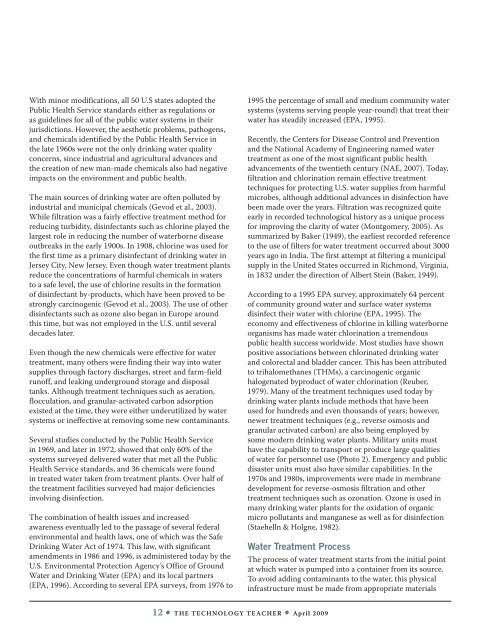Design Your Own Underwater ROV - International Technology and ...
Design Your Own Underwater ROV - International Technology and ...
Design Your Own Underwater ROV - International Technology and ...
Create successful ePaper yourself
Turn your PDF publications into a flip-book with our unique Google optimized e-Paper software.
With minor modifications, all 50 U.S states adopted the<br />
Public Health Service st<strong>and</strong>ards either as regulations or<br />
as guidelines for all of the public water systems in their<br />
jurisdictions. However, the aesthetic problems, pathogens,<br />
<strong>and</strong> chemicals identified by the Public Health Service in<br />
the late 1960s were not the only drinking water quality<br />
concerns, since industrial <strong>and</strong> agricultural advances <strong>and</strong><br />
the creation of new man-made chemicals also had negative<br />
impacts on the environment <strong>and</strong> public health.<br />
The main sources of drinking water are often polluted by<br />
industrial <strong>and</strong> municipal chemicals (Gevod et al., 2003).<br />
While filtration was a fairly effective treatment method for<br />
reducing turbidity, disinfectants such as chlorine played the<br />
largest role in reducing the number of waterborne disease<br />
outbreaks in the early 1900s. In 1908, chlorine was used for<br />
the first time as a primary disinfectant of drinking water in<br />
Jersey City, New Jersey. Even though water treatment plants<br />
reduce the concentrations of harmful chemicals in waters<br />
to a safe level, the use of chlorine results in the formation<br />
of disinfectant by-products, which have been proved to be<br />
strongly carcinogenic (Gevod et al., 2003). The use of other<br />
disinfectants such as ozone also began in Europe around<br />
this time, but was not employed in the U.S. until several<br />
decades later.<br />
Even though the new chemicals were effective for water<br />
treatment, many others were finding their way into water<br />
supplies through factory discharges, street <strong>and</strong> farm-field<br />
runoff, <strong>and</strong> leaking underground storage <strong>and</strong> disposal<br />
tanks. Although treatment techniques such as aeration,<br />
flocculation, <strong>and</strong> granular-activated carbon adsorption<br />
existed at the time, they were either underutilized by water<br />
systems or ineffective at removing some new contaminants.<br />
Several studies conducted by the Public Health Service<br />
in 1969, <strong>and</strong> later in 1972, showed that only 60% of the<br />
systems surveyed delivered water that met all the Public<br />
Health Service st<strong>and</strong>ards, <strong>and</strong> 36 chemicals were found<br />
in treated water taken from treatment plants. Over half of<br />
the treatment facilities surveyed had major deficiencies<br />
involving disinfection.<br />
The combination of health issues <strong>and</strong> increased<br />
awareness eventually led to the passage of several federal<br />
environmental <strong>and</strong> health laws, one of which was the Safe<br />
Drinking Water Act of 1974. This law, with significant<br />
amendments in 1986 <strong>and</strong> 1996, is administered today by the<br />
U.S. Environmental Protection Agency’s Office of Ground<br />
Water <strong>and</strong> Drinking Water (EPA) <strong>and</strong> its local partners<br />
(EPA, 1996). According to several EPA surveys, from 1976 to<br />
1995 the percentage of small <strong>and</strong> medium community water<br />
systems (systems serving people year-round) that treat their<br />
water has steadily increased (EPA, 1995).<br />
Recently, the Centers for Disease Control <strong>and</strong> Prevention<br />
<strong>and</strong> the National Academy of Engineering named water<br />
treatment as one of the most significant public health<br />
advancements of the twentieth century (NAE, 2007). Today,<br />
filtration <strong>and</strong> chlorination remain effective treatment<br />
techniques for protecting U.S. water supplies from harmful<br />
microbes, although additional advances in disinfection have<br />
been made over the years. Filtration was recognized quite<br />
early in recorded technological history as a unique process<br />
for improving the clarity of water (Montgomery, 2005). As<br />
summarized by Baker (1949), the earliest recorded reference<br />
to the use of filters for water treatment occurred about 3000<br />
years ago in India. The first attempt at filtering a municipal<br />
supply in the United States occurred in Richmond, Virginia,<br />
in 1832 under the direction of Albert Stein (Baker, 1949).<br />
According to a 1995 EPA survey, approximately 64 percent<br />
of community ground water <strong>and</strong> surface water systems<br />
disinfect their water with chlorine (EPA, 1995). The<br />
economy <strong>and</strong> effectiveness of chlorine in killing waterborne<br />
organisms has made water chlorination a tremendous<br />
public health success worldwide. Most studies have shown<br />
positive associations between chlorinated drinking water<br />
<strong>and</strong> colorectal <strong>and</strong> bladder cancer. This has been attributed<br />
to trihalomethanes (THMs), a carcinogenic organic<br />
halogenated byproduct of water chlorination (Reuber,<br />
1979). Many of the treatment techniques used today by<br />
drinking water plants include methods that have been<br />
used for hundreds <strong>and</strong> even thous<strong>and</strong>s of years; however,<br />
newer treatment techniques (e.g., reverse osmosis <strong>and</strong><br />
granular activated carbon) are also being employed by<br />
some modern drinking water plants. Military units must<br />
have the capability to transport or produce large qualities<br />
of water for personnel use (Photo 2). Emergency <strong>and</strong> public<br />
disaster units must also have similar capabilities. In the<br />
1970s <strong>and</strong> 1980s, improvements were made in membrane<br />
development for reverse-osmosis filtration <strong>and</strong> other<br />
treatment techniques such as ozonation. Ozone is used in<br />
many drinking water plants for the oxidation of organic<br />
micro pollutants <strong>and</strong> manganese as well as for disinfection<br />
(Staehelln & Holgne, 1982).<br />
Water Treatment Process<br />
The process of water treatment starts from the initial point<br />
at which water is pumped into a container from its source.<br />
To avoid adding contaminants to the water, this physical<br />
infrastructure must be made from appropriate materials<br />
12 • The <strong>Technology</strong> Teacher • April 2009
















